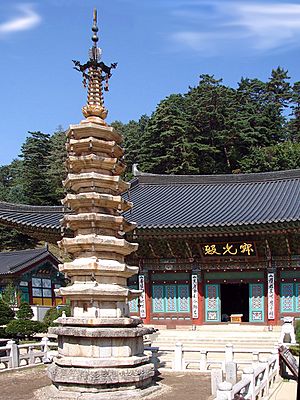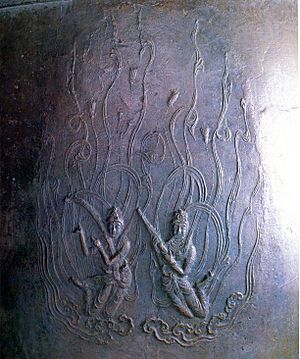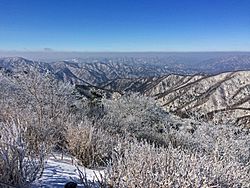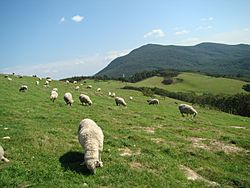Pyeongchang facts for kids
Quick facts for kids
Pyeongchang
평창군
|
||
|---|---|---|
|
County
|
||
| Korean transcription(s) | ||
| • Hangul | 평창군 | |
| • Hanja | 平昌郡 | |
| • Revised Romanization | Pyeongchang-gun | |
| • McCune-Reischauer | P'yŏngch'ang-gun | |

Alpensia Resort and a wind farm in Pyeongchang
|
||
|
||
| Etymology: 平 "peaceful" or "flatland", 昌 "prosperity" or "flourishing" | ||
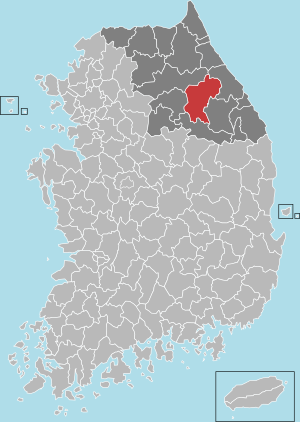
Location in Gangwon Province, South Korea
|
||
| Country | South Korea | |
| Province | Gangwon-do | |
| Administrative divisions | 1 eup, 7 myeon | |
| Area | ||
| • Total | 1,463.65 km2 (565.12 sq mi) | |
| Population
(2013)
|
||
| • Total | 43,666 | |
| • Density | 30/km2 (80/sq mi) | |
| • Dialect | Gangwon | |
| Time zone | UTC+9 | |
Pyeongchang is a county in the province of Gangwon-do, South Korea, located in the Taebaek Mountains region. It is home to several Buddhist temples, including Woljeongsa. It is about 180 km (110 mi) east southeast of Seoul, the capital of South Korea, and connected by expressways and high-speed passenger railways. Pyeongchang's slogan, "Happy 700 Pyeongchang", is taken from its average elevation of approximately 700 metres (2,300 ft).
Pyeongchang hosted the 2018 Winter Olympics and the 2018 Winter Paralympics. It was officially rebranded as "PyeongChang" (with a capital 'C') for the purposes of the 2018 Games, in order to avoid confusion with Pyongyang in North Korea.
Contents
History
Pyeongchang region was ruled by the Goguryeo Dynasty during the Three Kingdoms period, and it was called Uk-o-hyeon (욱오현). After the Silla dynasty conquered the Goguryeo Dynasty and Baekje Dynasty, it was renamed Baek-o-hyeon (백오현).
After the Goryeo Dynasty was established, it renamed Pyeongchang-hyeon. Then, it was under control of Wonju. When a 10-provincial system was enforced, the north of Pyeongchang region was involved in Sakbang-do, and the south of the region was involved in Jungwon-do. When a new administrative system was carried out by King Hyeonjong, the east of the region was involved in Dong-gyeo, and the rest of it was included in Yanggwang-do. An administrator for the region was sent from the central government, and it became independent of Wonju in 1299.
When the Joseon Dynasty was founded in 1392, the region was promoted from a hyeon to a county (gun). After the territory was divided into 8 Provinces under the reign of King Taejong, it was involved in Gangwon-do. After the territory was divided into 23 districts in 1895 with the 8-provincial system abolished, it was included in Chugju-bu. When a 13-provincial system was enacted in 1896, it was involved in Gangwon-do.
Geography
The altitude of Pyeongchang is wide-ranging, with 84% of its territory comprising mountains with average elevations of 750 m (2,460 ft).
Its best-known place, the township of Daegwallyeong-myeon, averages between 700 and 800 m (2,300 and 2,600 ft) above sea level, with some areas over 1,000 m (3,300 ft) high.
Climate
Pyeongchang County experiences a warm-summer humid continental climate (Köppen climate classification: Dwb/Dfb). Pyeongchang's winters are long and very snowy, while summers are relatively short.
Average temperature of Pyeongchang from 2001 to 2010 was 7.0 °C, and it was lower than Gangwon's 8.9 °C. Annual precipitation of the region from 2001 to 2010 was 1,555.0 mm, and it was more than Gangwon's 1,491.5 mm.
The warmest months of the year are July and August, with January and February being the coldest.
| Climate data for Daegwallyeong, Pyeongchang (1981–2010, extremes 1971–present) | |||||||||||||
|---|---|---|---|---|---|---|---|---|---|---|---|---|---|
| Month | Jan | Feb | Mar | Apr | May | Jun | Jul | Aug | Sep | Oct | Nov | Dec | Year |
| Record high °C (°F) | 8.7 (47.7) |
16.5 (61.7) |
19.7 (67.5) |
30.1 (86.2) |
31.0 (87.8) |
32.3 (90.1) |
32.9 (91.2) |
32.7 (90.9) |
29.0 (84.2) |
24.7 (76.5) |
21.5 (70.7) |
13.5 (56.3) |
32.9 (91.2) |
| Mean daily maximum °C (°F) | −2.5 (27.5) |
−0.4 (31.3) |
4.4 (39.9) |
12.9 (55.2) |
17.6 (63.7) |
20.5 (68.9) |
22.8 (73.0) |
22.8 (73.0) |
18.6 (65.5) |
14.0 (57.2) |
7.0 (44.6) |
0.5 (32.9) |
11.5 (52.7) |
| Daily mean °C (°F) | −7.7 (18.1) |
−5.5 (22.1) |
−0.5 (31.1) |
7.0 (44.6) |
11.9 (53.4) |
15.7 (60.3) |
19.1 (66.4) |
19.1 (66.4) |
14.1 (57.4) |
8.3 (46.9) |
1.3 (34.3) |
−4.4 (24.1) |
6.6 (43.9) |
| Mean daily minimum °C (°F) | −12.6 (9.3) |
−10.5 (13.1) |
−5.2 (22.6) |
1.2 (34.2) |
6.3 (43.3) |
11.2 (52.2) |
16.0 (60.8) |
16.1 (61.0) |
10.0 (50.0) |
3.1 (37.6) |
−2.8 (27.0) |
−9.1 (15.6) |
2.0 (35.6) |
| Record low °C (°F) | −28.9 (−20.0) |
−27.6 (−17.7) |
−23.0 (−9.4) |
−14.6 (5.7) |
−4.7 (23.5) |
−1.7 (28.9) |
4.4 (39.9) |
3.3 (37.9) |
−2.3 (27.9) |
−9.9 (14.2) |
−18.7 (−1.7) |
−24.7 (−12.5) |
−28.9 (−20.0) |
| Average precipitation mm (inches) | 62.6 (2.46) |
53.6 (2.11) |
75.6 (2.98) |
89.5 (3.52) |
122.3 (4.81) |
201.0 (7.91) |
326.7 (12.86) |
420.9 (16.57) |
307.3 (12.10) |
124.9 (4.92) |
76.9 (3.03) |
36.8 (1.45) |
1,898 (74.72) |
| Average precipitation days (≥ 0.1 mm) | 10.5 | 10.5 | 11.3 | 9.5 | 11.1 | 13.2 | 17.6 | 17.8 | 13.0 | 8.7 | 10.1 | 9.4 | 142.7 |
| Average snowy days | 13.0 | 11.8 | 12.0 | 3.3 | 0.2 | 0.0 | 0.0 | 0.0 | 0.0 | 0.8 | 5.2 | 10.9 | 57.2 |
| Average relative humidity (%) | 67.3 | 67.0 | 67.5 | 61.0 | 68.4 | 79.2 | 85.7 | 87.0 | 84.6 | 75.2 | 69.9 | 67.3 | 73.3 |
| Mean monthly sunshine hours | 197.2 | 185.2 | 202.3 | 226.6 | 229.4 | 179.8 | 138.1 | 130.7 | 143.9 | 193.3 | 176.4 | 191.9 | 2,194.8 |
| Percent possible sunshine | 64.4 | 60.8 | 54.6 | 57.4 | 52.1 | 40.7 | 30.8 | 31.0 | 38.6 | 55.5 | 57.8 | 64.3 | 49.3 |
| Source: Korea Meteorological Administration (percent sunshine and snowy days) | |||||||||||||
Culture and tourism
Cultural heritage sites
In Pyeongchang, 16 heritage sites were registered by the South Korean government, and 45 Heritages were registered by the Gangwon Provincial Office.
The count of cultural heritage designations is as follows.
- Registered by the Nation: 5 National Treasures, 5 Treasures, 1 Historic Site, 3 Natural Monuments, 1 National Folklore Cultural Heritage, 1 Registered Cultural Heritage
- Registered by the local government: 29 Tangible Cultural Heritages, 2 Intangible Cultural Heritages, 4 Monuments, 10 Cultural Heritage Materials
Temples
Sangwansa is a temple on Odaesan Mountain that was originally established as Jinyeowon in 705. Although the Joseon Dynasty's policy was the prohibition of Buddhism, it constantly donated to rebuild the temple. In 1401, King Taejong donated to the construction of Sajaam Hermitage. In 1465, King Sejo and administrators donated to rebuild the temple. Sejo's son, King Yejong designated it as a memorial for his father. During the Third Battle of Seoul, the United Nations Command ordered that the temple be burned, but a Buddhist monk prevented it. Instead, the Command agreed to burn only the doors of the temple.
Sangwonsa has the following cultural heritage sites:
- The Bell of Sangwonsa (National Treasure No. 36)
- Promotion of Virtue for Rebuilding Sangwonsa (National Treasure No. 292)
- Wooden seated figure of the Manjusri Child in Sangwonsa (National Treasure No. 221)
- Wooden seated figure of the Manjusri Child's Enshrined Heritages in Sangwonsa (Treasure No. 793)
- Wooden seated figure of Manjusri and its Enshrined Heritages in Sangwonsa (Treasure No. 1811)
- Wooden sedentary figure of Manjusri's Enshrined Classical Kooks in Sangwonsa (Treasure No. 1812)
Woljeongsa is a temple on Odaesan Mountain established by Jajang the monk in 643. After it was established, it was consistently rebuilt. During the Third Battle of Seoul, 10 buildings were totally destroyed by fire. Tanheo the monk restored Jeokgwangjeon, one of the burnt buildings, in 1964, and Manhwa the monk gradually reconstructed other buildings.
Woljeongsa has the following cultural heritage sites:
- Octagonal Nine-story Stone Pagoda of Woljeongsa (National Treasure No. 48-1)
- Reliquaries of the Octagonal Nine-story Stone Pagoda of Woljeongsa (Treasure No. 1375)
- Stone seated figure of the Bodhisattva in Woljeongsa (National Treasure No. 48-2)
- Painting of Three Bodhisattvas originated from Wonju Guryongsa (Treasure No. 1855) (Placed in Wolljeongsa, possessed by Guryongsa)
- Clothes of the Buddhist monk Han-am (Registered Cultural Heritage No. 645)
Historic sites
The Pyeongchang Odaesan Historic Archive (Historic Site No. 37) was one of five archival locations in the latter part of the Joseon Dynasty for the Annals of the Joseon Dynasty and Sonwon-kyebo-kiryak.
Festivals
- Daegwallyeong Snow Festival
- Daegwallyeong Snow Festival began as "Daegwallyeong Winter Snow Festival" in 1992 by Daegwallyeong Ski Club. In 1993, the first festival was formally held. Events of the 1st festival were skiing competition for locals, games of making snowmen, snow sledge competition, and sledge competition. Some games were added to next festivals, such as traditional games and snow car raising.
- On 7–22 Feb 2018, 26th festival was held in hwenggye-ri, Daegwallyeong-myeon as a pre-event of the 2018 Winter Olympics. Events include an exhibition of snow figures, snow sledge competition, international naked marathon, traditional folk performances, and Hwangbyoungsan Mountain hunting game.
- Hyoseok Cultural Festival
- Pyeongchang is the hometown of Lee Hyo-seok, a Korean novelist, and this festival is held in Lee Hyo-seok Culture Village, where he grew up.
Museum
- Lee Seung-bok Memorial Hall
- The Lee Seung-bok Memorial Hall is located in Nodong-ri, Yongpyeong-myeon to memorialize Lee Seung-bok who was a South Korean boy murdered by North Korean commandos in 1968. It was established in 1982, with building a memorial statue for Lee. Lee's house was restored in 2000.
Tourism
Odaesan Mountain is the home of historical Buddhist temples including Sangwonsa and Woljeongsa. It was designated as a national park in 1975. The highest peak, Birobong Peak is 1,563 m (5,128 ft) high.
Two major ski resorts in the county were the home of the 2018 Winter Olympics. Alpensia ski resort has six slopes for skiing and snowboarding, with runs up to 1,400.0 m (4,593.2 ft) long, for beginners and advanced skiers, and an area reserved for snowboarders. The resort is open year-round. Alpensia hosted the majority of the Olympic snow events. Yongpyong Resort, which has a total of 28 ski slopes, hosted the technical alpine skiing events.
Alpensia will be the focus of the 2018 Cultural Olympiad, with a new, purpose-built concert hall within the resort with an indoor water park.
Samyang Ranch is the largest highlands farm in Asia, located in the hills of Daegwallyeong at 850 to 1,470 meters above sea level. It is operated as a petting zoo and features a pastoral landscape. The ranch is operated by the leading Korean food and dairy company Samyang food, the first company to introduce ramyeon instant noodles into a poverty-ridden South Korea in the 1960s. It is the filming location of the drama Autumn in My Heart and the movie Lover’s Concerto.
Images for kids
See also
 In Spanish: Pieonchang para niños
In Spanish: Pieonchang para niños




